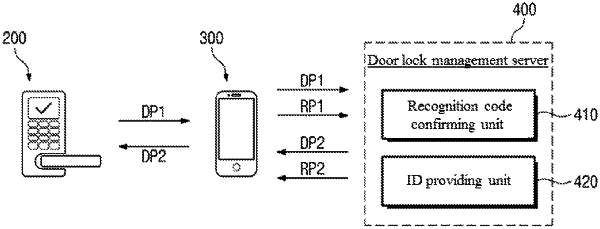| CPC G07C 9/00817 (2013.01) [G07C 9/00309 (2013.01); G07C 9/00571 (2013.01); G07C 9/00904 (2013.01); H04L 9/088 (2013.01); H04L 9/30 (2013.01); G07C 2009/00412 (2013.01)] | 19 Claims |

|
1. A door lock comprising:
a door lock body installed on a door and having an opening/closing device for opening and closing the door;
a memory embedded in the door lock body to store a door lock identifier including a door recognition code assigned to the door and a door lock identification (ID) corresponding to the door recognition code;
an antenna provided in the door lock body to sequentially receive a first radio frequency (RF) signal and a second RF signal from a reader; and
a control unit configured to transmit when the door lock receives the first RF, the door recognition code to the reader through the antenna such that the door recognition code together with a reader recognition code previously assigned to the reader is authenticated by a door lock management server that is communicatively connected with the reader and configured to determine, when the door lock receives the second RF, whether the door lock ID provided from the door lock management server through the reader matches the previously assigned door lock ID of the door lock identifier to control the opening/closing device such that the door is maintained in a lock state or released from the lock state,
wherein authentication to the door recognition code is determined according to an authentication result of the reader recognition code by the door lock management server,
wherein the memory further stores a server private encryption key (Priv_Server),
wherein the control unit includes:
a random number generation unit configured to newly generate a random number based on the first RF signal to encrypt the door recognition code whenever the first RF signal is received;
an encryption key generation unit configured to generate a door lock private encryption key (Priv-d) by using the random number generated from the random number generation unit, generate a door lock public encryption key (Pub_d) based on the door lock private encryption key (Priv_d), and generate a shared encryption key (S Key) by utilizing one of the door lock private encryption key (Priv-d) and the door lock public encryption key (Pub_d) and the server private encryption key (Priv_Server); and
an encryption unit configured to encrypt the door recognition code stored in the memory by using the generated shared encryption key (S Key), and
wherein, when receiving the first RF signal from the reader, the control unit is configured to:
generate the random number through the random number generation unit;
generate the door lock private encryption key (Priv_d), the door lock public encryption key (Pub_d) and the shared encryption key (S Key) through the encryption key generation unit;
encrypt the door recognition code with the shared encryption key (S Key) through the encryption unit; and
transmit a first door packet including the encrypted door recognition code and the generated door lock public encryption key (Pub_d) to the reader through the antenna.
|